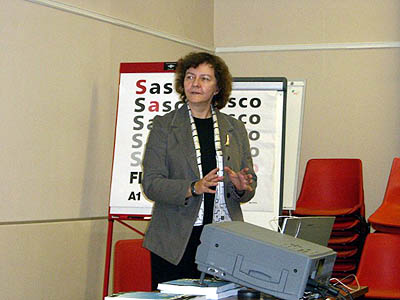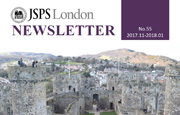JSPS Fellow's Experiences in Japan
Dr Barbara J Gabrys
(OUDCE and Department of Materials, University of Oxford)
JSPS Postdoctoral Fellowship for Foreign Researchers
Host institution: Kyoto Institute of Technology (March 1996 - May 1996)
Work and life in Japan of a JSPS Fellow
I went to Japan on invited short term JSPS Fellowship in the middle of my career as a physicist. I was working as Lecturer in Physics at Brunel University, supervising five PhD students, several final year students, giving undergraduate lectures and engaging in various administrative duties. When the time for my sabbatical leave came, Professor Kanji Kajiwara from the Faculty of Engineering and Design,Kyoto Institute of Technology had invited me to spend it working with his group. So I was in Kyoto, from 4th March to 31st May 1996. But this is only a middle of a very long story!
My fascination with Japan and things Japanese goes back to my teenage years. However it was only when I was an RA in the group of Professor Dame Julia Higgins at Imperial College that I had an opportunity to go to Japan. It was 1985, and I was awarded a Royal Society Fellowship to work for five months in Kyoto University. My host was Professor Ryozo Kitamaru who was a head of a research group specialising in NMR and neutron scattering investigations of structure and dynamics of polymers. This group was a part of the Institute for Chemical Research, based in Uji. I was renting a small flat nearby the Institute, and in general tried to live a life of a native. That included long working hours, an occasional drink in a pub, and participation in parties and outings. As often as I could I went to Kyoto . this venerable city is one of my favourite cities in the world. It was a great time for both scientific and personal development; the only regret I have is that I did not learn at least some Japanese prior to stay in Japan. While there, it was not easy either: there were no short, intensive courses available, and I could not afford private tuition.
This stay was a beginning of a long-collaboration which blossomed when I started working as Lecturer in Physics in the Department of Physics, Brunel University. Professor Kitamaru was succeeded by Professor Keisuke Kaji, and Dr Hiroshi Urakawa came to the UK to work with me and Professor Higgins on the British Council fellowship. Back in Japan, he moved to the group of Professor Kanji Kajiwara at the Kyoto Institute of Technology (KIT). This way I was able to work in KIT, and maintain contact with my 'old' group in Uji.
The subject of my fellowship was Molecular Modelling of Polymers and Copolymers. The principal aim was to gain a deeper insight into the structure/property relationship of ionomer blends as part of the process of the continuing improvement of materials. Molecular modelling was then just beginning and we were able to do only a limited work on modelling of the (sulphonated) poly-butylene terephthalate and polycarbonate blends while I was in Japan. However this work was continued upon my return to the UK by one of my PhD students. We had also published one joint paper in the field of polyelectrolytes.
This stay was rather different experience to that of my first one since the fellowship grant was very generous. I lived very cheaply in the university accommodation and during the week had meals with my host group in the canteen. In the week-ends I was able to explore Kyoto, its surroundings, interesting restaurants and baths. I was exploring new temples and shrines as well as visiting my favourite ones. I had also acquired some smattering of the Japanese language, and started to get more feel for the social structure and hierarchy of the Japanese society.
When Professor Toshiji Kanaya succeeded Professor Kaji, the continuity of collaboration in the field of polymers remained, and we had a succession of several small exchange grants as well as several neutron scattering research programs.
It is not easy to sum up my experiences of life and work in Japan: it is a complex combination of expectations and reality. If I would offer any advice to aspiring fellows, it is to not to be afraid! Initial introduction through a common acquaintance or friend is always helpful, and with some effort on both sides a foreign researcher . a gaijin . will fit into his or hers host group. Group is a key word, perhaps more so than in Europe.
When I think about Japan, so many things come to my mind I would urge you to go and explore Japan yourself!
At the JSPS Programme IntroductionEvent at University of Oxford on the 23rd November 2006






